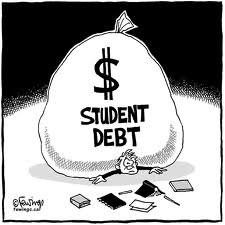- You are here:
- Home »
- Top Story »
- U.S. student debt hangover ruins that “American dream” (ha, ha)
U.S. student debt hangover ruins that “American dream” (ha, ha)

Angela Gambetta, Managing Director/The Posse List
9 May 2015 – About a decade ago, American consumers seemed the most debt-addicted people on the planet. Then … bingo … around 2008 something rather remarkable began to occur: the level of consumer card and mortgage debt in the US began shrinking.
But there is one glaring exception to this trend: student debt. Over the past decade, the level of outstanding student debt has almost tripled to $1.3 trillion.
Although the law makes it relatively hard to walk away from student debt, defaults are also strikingly high. There are many ways to measure this figure but the Department of Education reports that Americans who were due to start repaying their student debts in 2011 had a 13.7 per cent default rate last year. This is a touch lower than the previous year (14.7 per cent) but dramatically higher than it had been since the mid-1990s; and it is higher than the credit card default rate.
Student loan shark
But this figure may understate the problem, however. The Treasury Borrowing Advisory Committee released a report late last year which suggests that actual defaults (using its data) were just 9 per cent but the “shadow” default rate — the debt “delinquencies” that are not fully reported — could be 23 per cent. Other economists have similar estimates.
For law students/lawyers the discussion and debate has focused on the value and changing economic viability of a law degree. For law school students, the issues are plain enough: (1) we may be producing more law school graduates than there’s need; (2) law students are racking up an average $102,000 in debt because of the implied promise of a high-paying job at the end of the line; and (3) a massive portion of law school applicants are extremely ill-informed about the career prospects resulting from a law degree. The slew of cases against law schools for “padding” graduate employment statistics seems to continue unabated.
There are eerie parallels between the student loan tale and subprime mortgages. This is not because most pundits think that student debt is about to detonate a systemic financial crisis. Unlike subprime mortgages, student loans have not been repackaged into vast quantities of funky derivatives, or injected into a gigantic network of off-balance sheet entities. And since Federal guarantees backstop many student loans, it will be the government, not just private sector investors, taking much of the future hit.
But there are parallels.
First, the explosion in student loans, like subprime mortgages, is a byproduct of decades of stagnant wage growth. Although the cost of education has spiralled in recent years, incomes have not, prompting households to use debt to paper over the gap. The reason why consumers continue to do that, even if it defies economic logic, lies in a cultural imperative.
Second, education, like home ownership, is a deemed to be a crucial part of the American dream.
Third, it is hard for anyone to monitor what is going on because student loans have an ecosystem that is as fragmented as the subprime world. Most notably, those $1.3 trillion loans are being offered, monitored and serviced by numerous different providers.
And … no surprise … government agencies are struggling to cope, in part because of the fragmentation and explosive growth. Student loans are mostly overseen by the Department of Education. But the bureaucrats seem ill-equipped to cope as a once-modest sector becomes dizzyingly large. Sector fragmentation is also hampering efforts to create proactive policies to deal with the pattern of defaults: multiple schemes exist to offer help to struggling borrowers but these are being implemented in a confusing, piecemeal way. The helter skelter application of various public service loan forgiveness programs being only one example.
Oh, and the politicians, batting around possible solutions. Some Republicans want to end state support for student loans, while Elizabeth Warren, the Democratic senator, is among those who want to slash the interest rates on loans, not least because many students who took out debt a few years ago are locked into sky-high rates of 8 per cent.
The more reasonable talking heads … like Sarah Raskin, a lawyer and Deputy Secretary of the U.S. Department of the Treasury, who has been focusing on this issue … says what we need is to make the sector more transparent and create a consistent, clear process to help consumers renegotiate debt they cannot repay. This, she argues, would keep those defaults under control and make the costs much clearer.
Sensible stuff. Which means the politicians and government mandarins will never accept it. Modest ideas never fly in Washington. And we have the usual “turf wars” in Washington. In a recent piece The New York Times noted that the Department of Education is, unsurprisingly, reluctant to let the Treasury trample on its turf. And recent history shows how hard it is to devise sensible debt forgiveness when bureaucracies and financial companies are fragmented. Look at how the Treasury and White House failed to develop a truly effective policy to help subprime mortgage borrowers.
For the moment, the depressing reality is that there is little chance of this $1.3 trillion debt shrivelling. That is bad news for millions of households. But it is also unwelcome for the American economy, which can ill-afford to be weighed down by this oft-ignored debt mountain.


